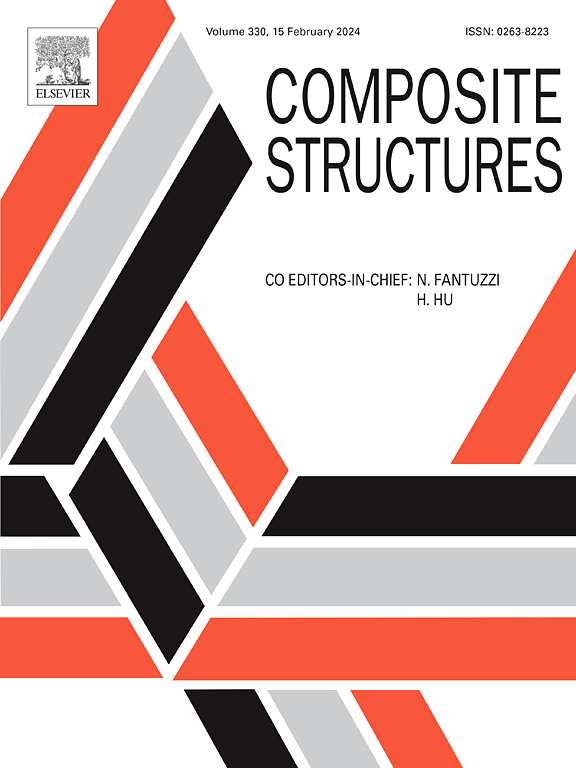复合材料复合结构蜂窝面内压缩变形响应及增强吸能能力
IF 6.3
2区 材料科学
Q1 MATERIALS SCIENCE, COMPOSITES
引用次数: 0
摘要
返回式混合蜂窝结构由于其出色的面内压缩性能而备受关注,但如何在能量吸收和消声效应之间取得平衡仍然是一个重大挑战。为了解决这个问题,我们提出了一种新型的可重新进入的钻石增强蜂窝(RE-DEH),它结合了两种几何设计:可重新进入的蜂巢(REH)和钻石增强的蜂巢(DEH)。与相同壁厚的REH相比,RE-DEH具有更高的比刚度和比能量吸收(SEA)。此外,几何构型的参数化研究表明,REH的倾角a是控制能量吸收能力和泊松比的主要因素。使用双材料结构的进一步优化-将不同刚度的改性PLA材料应用于REH和DEH区域-将平均泊松比的幅度降低了50%(从- 0.36降至- 0.54),同时保持较低的相对密度。同时,这种设计将SEA提高到1.20 J/g,比单一材料的同类产品提高了23.71%。因此,双材料结构设计是克服能量吸收与消声效应权衡的有效策略,为蜂窝结构优化提供了新的途径。本文章由计算机程序翻译,如有差异,请以英文原文为准。
Deformation response and enhanced energy absorption capacity of a novel re-entrant honeycomb with hybrid structures and bi-material under in-plane compression
Re-entrant hybrid honeycomb attracts significant attention due to its excellent in-plane compression performance, yet achieving a balance between energy absorption and auxetic effects remains a significant challenge. To address this, we propose a novel re-entrant diamond-enhanced honeycomb (RE-DEH) that combines two geometric designs: the re-entrant honeycomb (REH) and diamond-enhanced honeycomb (DEH). Compared to REH with identical wall thicknesses, the RE-DEH demonstrates significantly higher specific stiffness and Specific Energy Absorption (SEA). Additionally, a parametric study of the geometric configuration reveals that the inclination angle of the REH is the dominant factor governing both energy absorption capacity and Poisson’s ratio. Further optimization using a bi-material configuration − where modified PLA materials of varying stiffness are applied to REH and DEH regions − reduces the magnitude of the average Poisson’s ratio by 50 % (from −0.36 to −0.54) while maintaining low relative density. Simultaneously, this design increases the SEA to 1.20 J/g, representing a 23.71 % enhancement over single-material counterparts. Therefore, the bi-material structure design is an effective strategy to overcome the trade-off between the energy absorption and auxetic effect, providing a new approach for the optimization of honeycomb structure.
求助全文
通过发布文献求助,成功后即可免费获取论文全文。
去求助
来源期刊

Composite Structures
工程技术-材料科学:复合
CiteScore
12.00
自引率
12.70%
发文量
1246
审稿时长
78 days
期刊介绍:
The past few decades have seen outstanding advances in the use of composite materials in structural applications. There can be little doubt that, within engineering circles, composites have revolutionised traditional design concepts and made possible an unparalleled range of new and exciting possibilities as viable materials for construction. Composite Structures, an International Journal, disseminates knowledge between users, manufacturers, designers and researchers involved in structures or structural components manufactured using composite materials.
The journal publishes papers which contribute to knowledge in the use of composite materials in engineering structures. Papers deal with design, research and development studies, experimental investigations, theoretical analysis and fabrication techniques relevant to the application of composites in load-bearing components for assemblies, ranging from individual components such as plates and shells to complete composite structures.
 求助内容:
求助内容: 应助结果提醒方式:
应助结果提醒方式:


